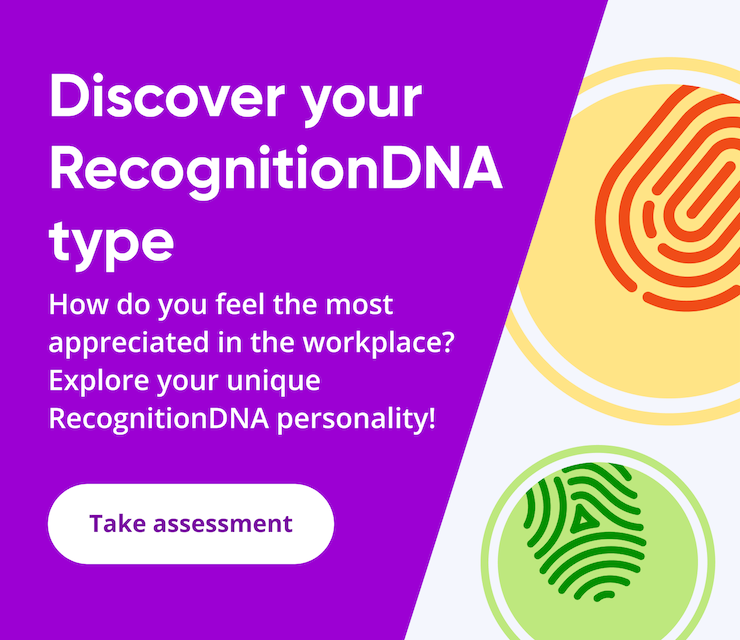
Company culture used to be synonymous with office culture.
A “cool culture” meant outrageous perks, fun office decor, scooters in the hallway. You get the idea.
Of course, that was never quite true. Yes, culture is expressed in tangible things like the office, but at its core, culture is much more invisible. It’s the values and norms that guide behavior. It’s the way you and your team show up in the world.
Want to really understand an organization’s culture?
Look at how they communicate. Look at who they recognize and how. Look at a tough decision, and the calculations that went into making. Most of all, culture is fluid. It’s constantly being made and remade by your people. As a leader, you must be vigilant in guiding it.
But, culture and offices did go hand and hand. Building – and scaling – culture in a dispersed environment is much more difficult.
Connection, recognition, and care are all crucial to building and maintaining your organization’s culture. Historically, these outcomes were much easier to achieve in offices. Indeed, the best offices were designed specifically with them in mind.

The migration from office to home-office has made culture building that much harder. While the situation is bound to improve eventually, there will be no return to “normal.” Work has changed in permanent ways. It too is fluid.
All signs point to a hybrid situation, with employees spending part – or all – of their time working remotely. The days of HQs at full capacity are over. As a people-focused leader and culture builder, it is your job to plan for and build around this new reality, and set your people up for success.
In the fluid workplace where so much of our interaction is virtual, companies and people-focused leaders face a difficult question: what does culture even look like now?
The answer is Cloud Culture.

Cloud Culture is culture building for work-from-anywhere teams. Cloud Culture takes the things we loved about our tangible, communal office culture, individualizes them, and reimagines them for the unique demands of right now… and tomorrow.
Building an effective Cloud Culture can seem like a daunting task, but you can succeed by focusing on a few fundamentals. A great Cloud Culture empowers you to reach out and connect your dispersed team – to each other, to the organization, and to their work.
To make it easy to understand and implement, we’ve developed the REACH framework, 5 pillars for building your own Cloud Culture.

The REACH Framework for Building a Highly Effective Cloud Culture
Recognition
We know that recognition is a powerful driver of retention and inspires employees to feel connected to their work. One global study by O.C. Tanner found that companies who recognize small wins saw an 83% uptick in engagement.
Recognition need not be overcomplicated, but it must be consistent. One of the best ways to recognize your team is by celebrating milestones. Studies show that employees tend to leave their companies around these milestones, especially work anniversaries, a natural opportunity for professional reflection. A well-timed moment of employee care can reinforce your commitment to their wellbeing, and increase the likelihood of retaining your top employees.
An effective Cloud Culture builds in tangible moments of recognition for each employee throughout the year, timed to big milestones and small wins alike.
Emotion
As an HR leader, right now your biggest challenge – and most important responsibility – is supporting your team emotionally. Why? Because emotion and engagement go hand-in-hand. Engaged employees go above and beyond because they feel deeply that the company’s success is their success too. They relate to your organization mission, values, and way of doing business. An effective Cloud Culture fosters emotional bonds by making employees feel seen, heard, and cared for while reinforcing the values your company stands for.
Adaptability
Fluidity will be the defining feature of work in the future. According to the New York Times, trend-setting workplace like Google, Uber, Slack, and Airbnb all postponed their return to the workplace until at least the summer of 2022. What’s more a recent Gallup study found that 59% – or 3 out of 5 – U.S. workers who have been doing their jobs from home during the pandemic would prefer to continue to work remotely as much as possible – even after social distancing restrictions are lifted.
Any cloud culture program must be adaptable enough to keep pace with the changing nature of work. A Cloud Culture has to scale both vertically and laterally – up as your team grows, but also across a diverse array of work settings. Nimble logistics and ease of use are key.
Community
Team building – especially across departments – was so much easier in offices. But even in the pre-COVID days, 39% of employees in a Queens University study believed that people in their orgs didn’t collaborate enough.
This effect is amplified in our work-from-anywhere world. When teams are dispersed, it can be very easy for departments to become siloed. Case in point, a recent Culture Amp study found an 8% drop in employees who feel like they are “part of a community at work.”
Even if individual departments are communicating frequently, there’s a high likelihood that a sense of community between and across departments is suffering. Overcome this tendency with a Cloud Culture that includes team building and bonding activities that span multiple departments, and that can unite people despite geographic dispersion.
Happiness
Finally, your Cloud Culture should be designed to maximize employee happiness through personalized moments of care.
While employee happiness and engagement aren’t synonymous (you can be happy at work without being personally invested or highly productive, for example), they are closely linked. That’s because engagement is an emotional phenomenon. Unhappy employees are not engaged, so building an engaged team requires a culture of care and happiness. Fostering feelings of goodwill is an essential part of any Cloud Culture strategy.
Personalization is a super effective way to do just that, as companies and their employees crave personalized experiences. In fact, boring, staid, or meaningless perks or care items will come across as empty gestures, and could do more harm than good.
It’s important to establish a uniform standard of care, while also creating individualized employee care experience that delivers moments of happiness. The goal should be to surprise and delight your team, and a tailored, personalized care experience will.
A focus on employees happiness can lead to a 300% rise in innovation, 50% increase in productivity, and 147% higher earnings per share. (Source: Delivering Happiness)
With this framework, you can begin to build a scalable, flexible Cloud Culture that keeps your team connected and engaged, and resilient enough to thrive in the ever-changing future of work.




